Li Qilin: A complete analysis of the banking supervision system


































































































editorial comment/note
In recent years, the city’s real estate transaction (surveying and mapping) industry has taken the opportunity to improve the efficiency of real estate transaction and property management services and push the city’s real estate transaction and property management level to a new level, further deepened various measures for the reform of real estate transaction registration services, and implemented all-round, multi-dimensional and three-dimensional "convenience for enterprises" services, making positive contributions to promoting the development of real estate transaction and property management. All real estate transaction (surveying and mapping) units in the city insist on business process design and reengineering, constantly improve the level of intelligent, accurate and personalized services, adhere to the deep integration of online and offline, constantly optimize the service model, create a quality service experience, further enhance the satisfaction of the window, and make the people have more sense of gain.
Behind the transaction applicants’ experience of better and more efficient services, the real estate transaction (surveying and mapping) industry in the whole city has further deepened the reform of "streamline administration, delegate power, strengthen regulation and improve services" and optimized the business environment around the service concept of "People’s Cities Build for People", which has enabled the real estate transaction (surveying and mapping) staff in the whole city to further change their work style, comprehensively improve their service level, self-pressurize, work overtime, work hard and unite as one, thus ensuring real estate transactions. In the near future, we will publish the reports about Do not forget your initiative mind and keeping in mind the mission in the reform of real estate transaction services of all real estate transaction (surveying and mapping) units in the city one after another, so as to promote the indomitable working attitude, enterprising spirit and strict and meticulous industry style.
Safeguarding economy and promoting development
Excellent business performance
-Changning District Housing and Land Surveying and Mapping Center
Changning District Housing and Land Surveying and Mapping Center was formed in March, 2003 by the merger of the Surveying Team of Changning District Real Estate Bureau and the Surveying and Mapping Department of Changning District Trading Center to meet the needs of the Ministry of Construction and the Municipal Real Estate Bureau. Focusing on the requirements of service development and service enterprises, Changning Surveying and Mapping Center takes "I do practical things for enterprises" as the main content, and carries out in-depth service activities of "I solve problems for enterprises and make contributions based on my post", and vigorously cooperates with the key work of District Housing Management Bureau, especially the "incomplete" transformation, focusing on safeguarding and improving people’s livelihood, and constantly boosting the steady progress of people’s livelihood.
First, based on their posts, to help prevent and control the epidemic.
In order to improve service efficiency, focus on prevention and control, and promote development at the same time, Changning District Housing and Land Surveying and Mapping Center stepped forward and took the initiative to connect with service enterprises, providing pre-stepping guidance and housing surveying and mapping services for key projects with initial specific conditions.
As a key project and supervised project in Changning District, Fuquan Road Underground Passage Project is not only a traffic artery, but also a large shopping mall IKEA nearby. Changning Surveying and Mapping Center attaches great importance to this kind of project involving people’s livelihood, helping enterprises and optimizing business environment, and the district Committee also attaches great importance to it. However, since the Fuquan Road Underground Passage Project was established during the epidemic, it has been full of difficulties. Previously, the underground passage project of Fuquan Road has been surveyed and mapped many times, and the planning scope has been adjusted many times. The project situation is complicated, and all aspects involved make everyone feel that they can’t start, so they need to take a long-term view. Finally, the equipment problem was solved, and another problem slowly surfaced on the water. When the surveying and mapping system was turned on, Changning Surveying and Mapping Center found that the "encryption key" needed for surveying and mapping work had expired, and it was put in the past. The renewal of the "encryption key" required me to submit information to the results department of the Municipal Information Center. However, due to the epidemic situation, many offices were in the closed-loop management stage at that time, and the results department of the Municipal Information Center was one of them. In order not to affect the progress of the project, Changning Surveying and Mapping Center urgently docked with the results department of the Municipal Information Center. After submitting relevant information and explaining the situation, it received strong support from the results department of the Municipal Information Center and established a temporary working mechanism. Changning Surveying and Mapping Center also successfully landed in the surveying and mapping system, and the underground passage project of Fuquan Road officially entered the final sprint stage.

▲ Surveying and Mapping of Fuquan Road Underground Passage Project
June coincides with the rainy season in Shencheng, with continuous heavy rain and light rain. The ownership investigators of Changning Surveying and Mapping Center carry forward the spirit of hard work and dare to fight, go to the scene for surveying and mapping in the rain, and work overtime when they return to their units. Finally, with the concerted efforts of Qi Xin, the underground passage project of Fuquan Road was completed ahead of schedule.
Two, explore and implement a new mode of surveying and mapping work
Under the background of centralized tasks of surveying and mapping projects and optimization of business environment, it is an effective way to improve the working mode and business development method of surveying and mapping results management in Changning Surveying and Mapping Center. Learn from professional strength, cooperate to improve efficiency, try our best to ensure the quality of surveying and mapping ownership survey, and also cultivate young employees’ professional skills in work practice, and take various measures to improve service efficiency.

▲ Changning Surveying and Mapping Center and Changning Trading Center exchanged views.
On May 19th, 2020, Zhang Jidong, director of Changning Surveying and Mapping Center, led a team to Changning Trading Center for discussion. At the exchange meeting, Secretary Ma Liangmin of Changning Trading Center talked about the problems encountered in business handling in recent years, and shared the solutions to the difficulties and the future business development direction. Subsequently, the two sides conducted in-depth exchanges and discussions on business processes, platform construction, team building and optimization of business environment. At the same time, we exchanged views on how to further cooperate and complete the business in the future, and put forward that in the environment of multi-unit combined work, relevant units should exchange and interact more, share more experiences, learn from each other’s strong points, share information and work together.
Three, pay attention to the city and district key projects, cooperate with the surveying and mapping work.
Changning Surveying and Mapping Center implements the deployment of the Municipal Housing Management Bureau on the confirmation and replacement of real estate in the school buildings of the city’s education system and municipal state-owned enterprises, and promotes the surveying and mapping work of the district real estate ownership certificate. In line with the working principle of "respecting history", we will adopt the working method of "historical passage" and "simple passage" to go hand in hand and classify, do a good job in surveying and mapping school building assets and municipal state-owned enterprises, and help solve problems left over from history such as unclear ownership of real estate and uneven warrants.

▲ Changning Surveying and Mapping Center went to the District Education Bureau for project surveying and mapping.
Fourth, optimize the "non-complete" surveying and mapping process to do practical things for the people.
The landing of "non-complete" property certificate is a livelihood project for the people, but because it involves dealing with residents and surveying and mapping, Changning Surveying and Mapping Center will work together with many departments to simplify the process, optimize the connection, and effectively promote the landing of "non-complete" property certificate for the people.


▲ Surveying and mapping personnel go to Tianyi Community for surveying and mapping.
With the renovation of "non-complete" houses in Tianyi Community entering the final stage, the field surveying and mapping work in Tianyi Community needs to be carried out in residents’ homes. In order to further speed up the surveying and mapping and improve the efficiency of surveying and mapping, Changning Surveying and Mapping Center decided to divide it into three surveying and mapping groups, led by party member, to survey and map several houses at the same time in two days. In the process of surveying houses from door to door by surveyors, the residents of Tianyi Community responded positively and cooperated very much, and expressed their understanding of the various processes in the survey work. Nevertheless, during the surveying and mapping period, there were many unexpected situations. For example, some residents arranged a tight schedule and demanded priority in surveying and mapping, which made it impossible to go door-to-door in surveying and mapping, but ran upstairs and downstairs, while some residents were not allowed to go home for surveying and mapping. In addition, some residents have been transformed privately, which is also a test for the eyesight of surveying and mapping workers. Some residents will ask some questions about surveying and mapping calculation, etc. There are all kinds of ideas among residents. Comrades from Changning Surveying and Mapping Center, Their common wish is to measure the area of each house smoothly and accurately, and provide reliable data for subsequent property registration.
Facing the future, all the staff of Changning District Housing and Land Surveying and Mapping Center will thoroughly implement the spirit of the 12th Party Congress in Shanghai, and make greater contributions to "accelerating the construction of a socialist modern international metropolis with world influence", practicing the people’s city concept, promoting high-quality development and creating a high-quality life.
Shangguan author: Fang keyuan
Foreword: Based on the industrial rust belt, integrating the beauty of old and new changes, and taking water as the pulse, we construct the idea of shuttling through the diversified life of the city
GATE M West Coast Dream Center opens a century-old new chapter in the river basin.
Rivers and coasts are often the source of a city’s development. Whether it’s the Canary Wharf on the Thames, ICON SIAM in Bangkok or the West Kowloon Cultural District in Hong Kong, many waterfront businesses rely on natural scenery and complement the waterfront to witness the vigorous development of the city.
Xuhui Riverside, on the west bank of Huangpu River in Shanghai, has been one of the most important watersides after a hundred years of development, from industrial rust to life show belt to science and technology embroidery belt today. On September 26th, GATE M West Coast Dream Center, a waterfront business in Xuhui Riverside, officially opened, which became an important breakthrough in the symbiotic development of art, culture and commercial consumption in Shanghai.
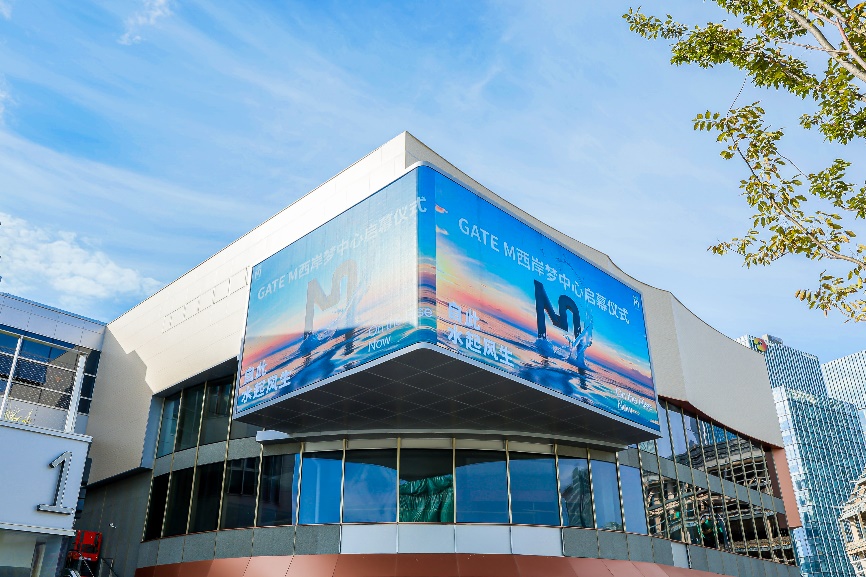
GATE M West Coast Dream Center, with a total construction area of about 162,000 square meters, was jointly built by West Coast Group and Huazhimen Capital, and Huazhi Wanliang provided property management services for the whole committee. Huazhi Wanliang was established by a joint venture between Huazhimen Capital and Wanwu Lianghang, and both parties jointly empowered their projects. The West Coast Dream Center is the first project put into operation by the joint venture company.
No.1 A century-old landmark, connecting old and new in series
From Shanghai Cement Plant to Waterfront Commercial District
Strolling along the waterfront and leisurely shopping are the unique charm of waterfront commerce. The West Coast Dream Center was originally located in Shanghai Cement Plant, the largest cement plant in Asia. In 2021, the West Coast Group signed a contract with Huazhimen Capital for cooperative development, retaining the original pre-homogenization warehouse, waste warehouse, cargo terminal and other landmark buildings, and building it into.800-meter-long commercial project close to the river view It is also the only waterfront business along the Huangpu River that is close to the riverbank.
The overall layout of the West Coast Dream Center is open. Inspired by the base planning of the cement plant, the Dream Center Avenue, which is parallel to the outer road Longteng Avenue and the waterfront Avenue, is used for north-south pedestrian traction. The project is equipped with a trail system, which is convenient for people to flow through all floors of the building and enjoy the river view at different heights.
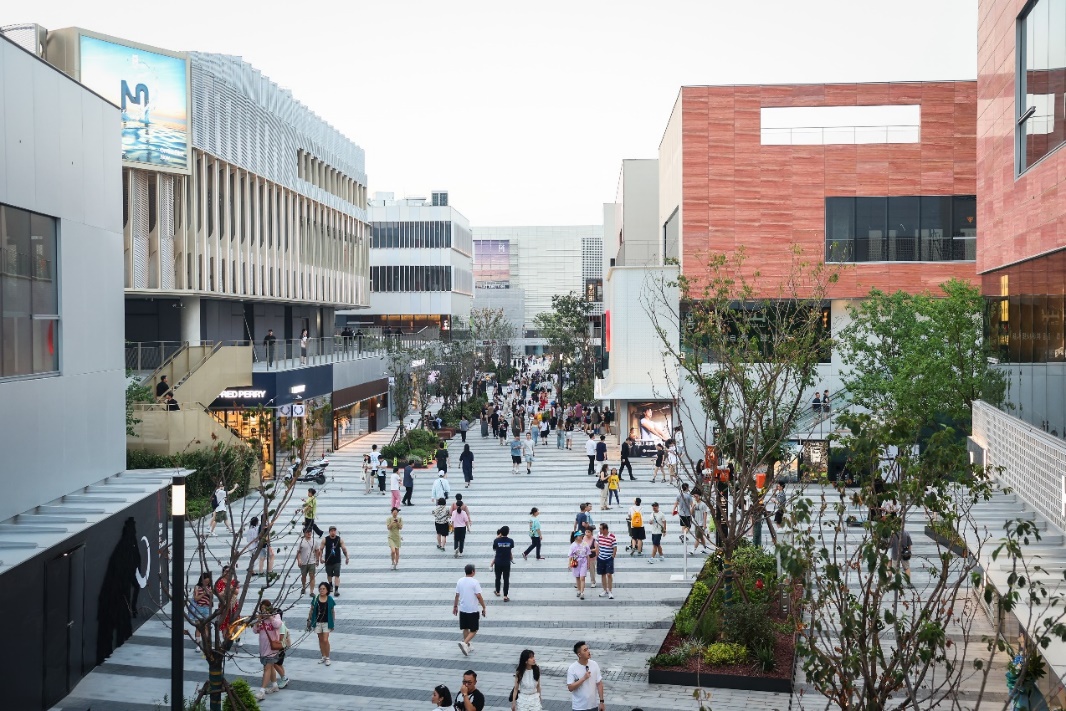
From the riverside waterfront to the project and then to the city road, people can shuttle through the internal street view space, but also insert into the riverside walkway space, seamlessly switching riverside vacation and leisure business. The highlight is that during the development and construction of the West Coast Dream Center, a cross-municipal road corridor was specially established to connect with the adjacent project International Media Port (PM service provided by Wanwu Lianghang), which introduced high-viscosity consumers of office buildings to the project.
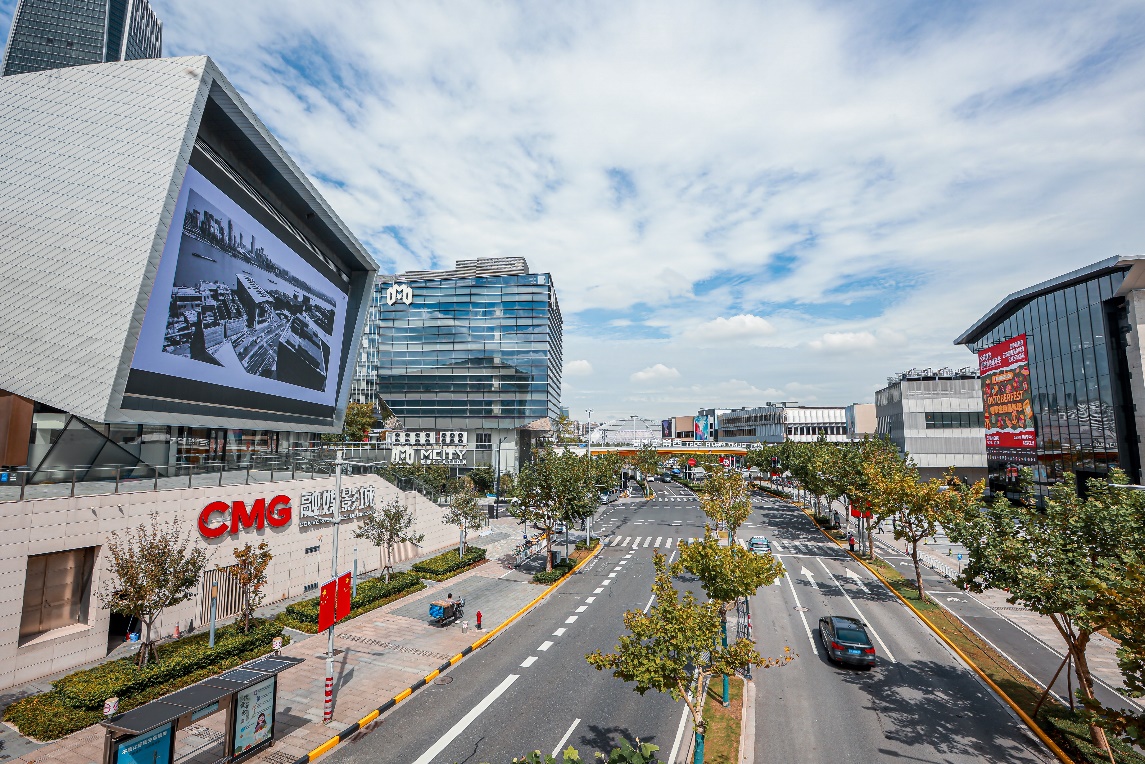
No.2 Multi-integration, strong brand lineup
Five lifestyles interact to complement the functions of the West Bank.
As an important commercial node on the golden coastline of the west bank, the project retains the existing structure of the cement plant as a whole, and integrates "industrial heritage", "Shanghai artistry" and "multiple experiences". The project is presented in five areas, namely, performing arts and culture area, sustainable fashion area, dream workshop, micro-holiday and leisure area and phenomenal urban outdoor area, which respectively represent a lifestyle and consumption concept, and further improve the functions and attributes of the West Coast area.
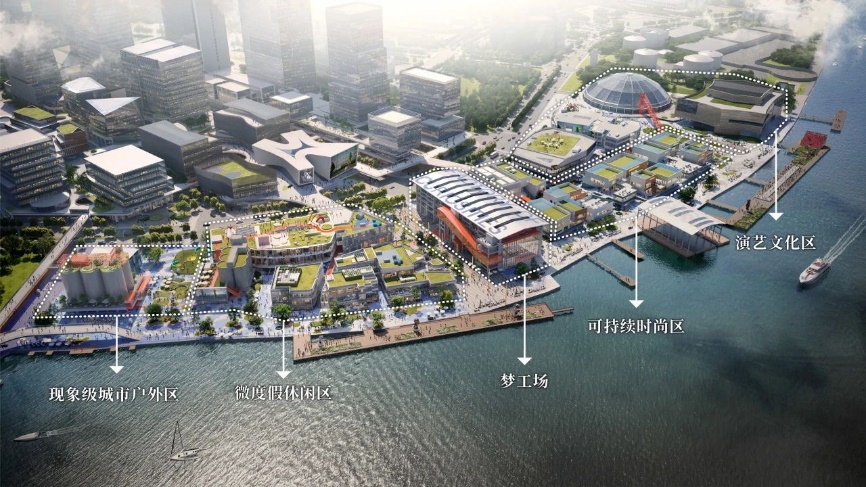
The performing arts cultural area in the north includes the West Coast Grand Theatre and the West Coast Dome Art Center, which are equipped with a more forward-looking art space in a double theater mode and with a large-scale activity space in the theater square.
The DreamWorks transformed from the old factory building in the middle will be divided into two parts, the first and second floors will be introduced into the waterfront market BLOOMARKET, and the third floor will be used as the curatorial space.
The silo area in the south is transformed from the original cement storage space, which creates enough space conditions for outdoor sports, and the silo will also be turned into a professional rock climbing space.
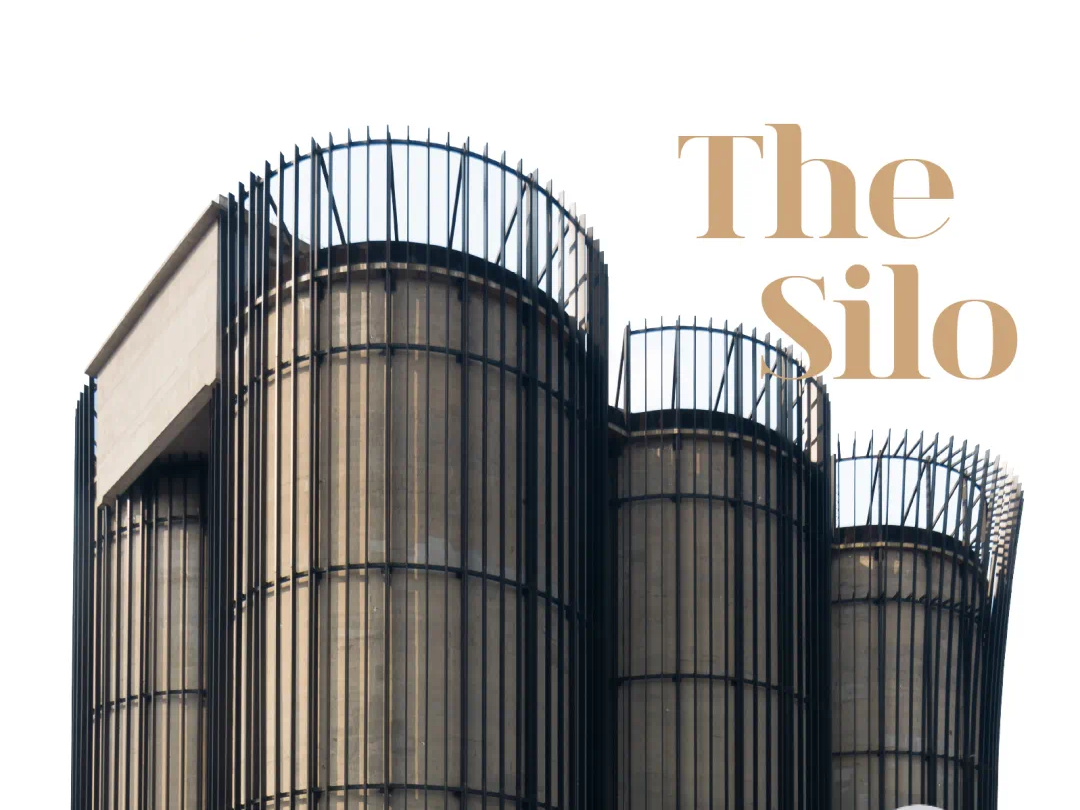
In terms of brand investment, the West Coast Dream Center has introduced a unique experience brand with its own passenger flow, an outdoor trend brand that is in the limelight, a niche but proven retail brand, and all-food catering. For example, BAPE GALLERY, which integrates art curation and retail and leads the new trend of art? , street trend collection store EXI.T, sports brands HELLY HANSEN, CGX, lululemon and Angpao, lifestyle brands Tagi and UODYCOCO, etc.
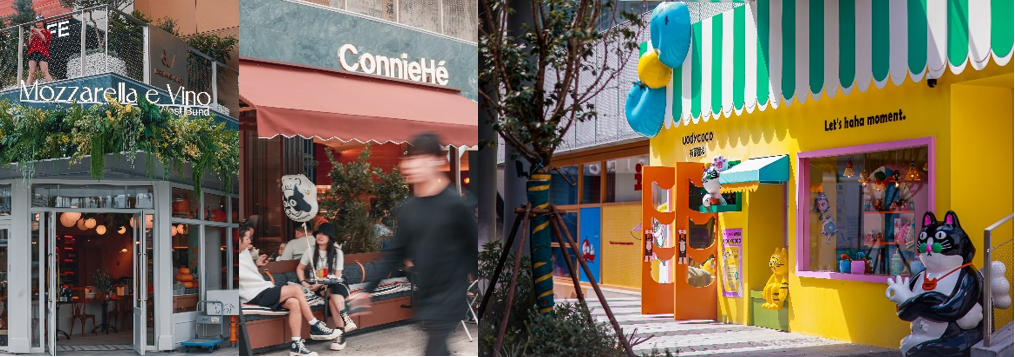
The staged opening strategy of the West Coast Dream Center, the continuous influx of passengers since the warm-up and the continuous hot search list from the media are enough to show that this business along the Yangtze River has sprung up.
In October, the West Coast Dream Center will be held as the Xuhui branch of the first Shanghai International Light and Shadow Festival to present gorgeous light and shadow art and retro roller skating theme parties, and other activities will be held one after another. , tile livehouse will also usher in the opening, and its attraction will continue to rise.
No.3 Chill Business, heart-warming service
Professional lifeguard standby 7*24 hours sense of security
Today, the waterfront often no longer assumes the function of a wharf, but people still linger on the waterfront, or take a walk, or sit around.
The West Coast Dream Center has laid out restaurants, tea drinks and coffee shops on the waterfront side, making full use of the riverside landscape and creating a social atmosphere in Chill. For example, grandma made a wide chair in front of the door facing the river. No matter day or night, it is always full of comfortable people.
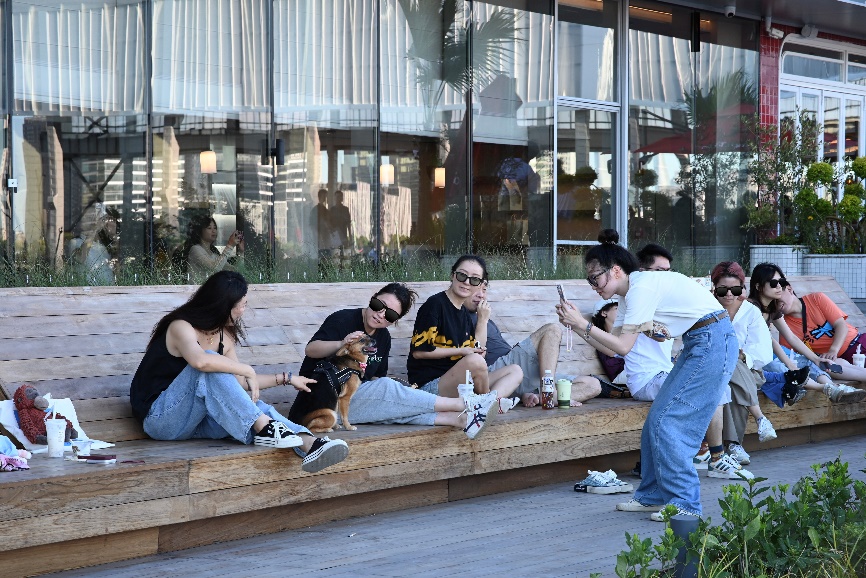
This kind of "well-shaped" planning project is not easy to manage. The super-long coastline of the West Coast Dream Center makes the plane scale of the project larger, accommodates more business scenes and is more difficult to manage.
Behind the protection of the Chill atmosphere and safety management of the project, the service team of Wanwu Liangxing has also done its homework.On the 800-meter coastline, service personnel can be seen everywhere, distributed in a scattered way, and providing mobile response services.

In view of the close proximity of the West Coast Dream Center to water, Wanwu Lianghang has deployed several service personnel with lifeguard certificates to ensure the emergency rescue needs for 7*24 hours. . In order to cope with the holiday crowd, the rapid recovery after extreme weather and the staged tidal passenger flow in the theater, the service team also prepared a variety of plans in advance.
No.4 Inclusive, go to class.
Inclusive, friendly, comfortable and harmonious new experience
Excellent commercial landmark service needs to be from the consumer’s point of view.
As an important memory plate of Shanghai’s historical development, the West Coast area is not only a place for old Shanghainese who are full of feelings to relive their punch cards, but also a favorite place for young artists, skateboarders and pet owners.
In the West Coast Dream Center, pet-friendly facilities and tips can be seen everywhere, such as pet-friendly conventions, dog drinking stations, special garbage bins for pet garbage, etc., providing services such as pet raincoats and pet rope rentals. This is also a new model that the service team has explored the collection of project attributes and formats after repeated practice, and joined hands with customers to upgrade pet friendliness.

Here, whether you want to walk, ride, slide, pet or walk, bicycles, strollers and scooters are free and harmonious. Service teams are arranged at entrances and exits to guide and inform matters needing attention in a more flexible way. (For safety reasons, the service team will advise you to get off the bus, please understand. )
At the moment when we are keen to return to life, the dream center operation and service team has created a very inclusive business atmosphere.Let more young people feel the comfort and relaxation of waterfront space here, and let more old Shanghainese feel the charm of urban development in retro.
As the mother river of the city and the central axis of development, Huangpu River is of irreplaceable significance to the development of Shanghai. The areas along the Huangpu River are unique and bear different roles and missions. Since the renovation, the West Bank (Xuhui Riverside) has continuously integrated its cultural media, science and technology business and ecological livable functional industries.

Now, the West Coast Dream Center, which sits 800 meters along the river coastline, has officially opened, which is not only a new voice and breakthrough in the structure of Shanghai’s commercial scenes, but also a new sample of Shanghai’s return to citizens’ life to provide waterfront leisure areas, and an important stroke in the renewal and development of Xuhui Riverside.
Xuhui Riverside is also the high-concentration layout place of Everything Liang Hang in Shanghai. . The Shanghai area of Wanwu Liangxing successively serves the enterprises’ workplaces, office buildings, art venues and commercial projects in the area, witnessing and accompanying the sustainable development of Xuhui Riverside. In Shanghai, Wanwu Lianghang continues to expand its commercial service capabilities, from large-scale commercial complexes to box-type businesses, and then to shopping blocks and community commercial MALL, adding color to the commercial prosperity of Magic Capital with diversified and customized services.
Official guide price: 173,800-264,800
There has been no new upgrade since its launch, but it has remained fresh through the mid-term change. At present, the latest 2023 model has been listed, and the new car mainly simplifies the layout of the model, upgrades the on-board system and provides new wheel styles.
this
The 2023 model has not been adjusted much, and the front face shape is less imposing than RAV4 Rongfang. Some people say that the detailed design of the new car is very interesting and the design is more exquisite. In fact, there is still a difference between our style and the avant-garde and bold route we are taking now. It looks a bit conservative, but it is indeed gentler and more approachable.

Although there is a little less momentum, the outline of the line is worth savoring, with rich layers and sharp edges. The new standard is automatic LED headlights.

When you come to the side of the car body, the floating roof is the current design, and you can also choose a two-color car body. For example, a white car body with a black top will also have a unique taste, provided that you add money. The length, width and height of the car body are 4665/1855/, with a wheelbase.

The details of the tail are even more intriguing. The taillights are surrounded by black, and the chrome plating is very delicate. The chrome plating on the back lip is also used properly.

The interior design is both soft and hard. Chrome plating and knob modeling show the tough side as an SUV, while the layered design of the dashboard, soft plastic-coated materials and two-color interior make it feel warmer and warmer.

Some models of the 2023 model are equipped with full LCD instrument panels, and the size is upgraded to 12.3 inches. In addition, all models are equipped with a 10.25-inch central control screen as standard, which supports /HiCar/ smart phone interconnection and voice control in the car.

Some models of model 2023 are equipped with T-Pilot driver assistance system, which adds the functions of intersection detection response and emergency turn signal light to TSS system.

The softness of the seat is moderate and the wrapping is quite sufficient. The angle of the seat back can also be adjusted. The disadvantage is that the cushion of the rear seat is a little short, and the horizontal arrangement of the front cup holder may interfere with the use of the driving mode button in front of you when placing the water bottle.
The 2023 model is equipped with a 2.0L engine with a maximum power of 126kW and a maximum torque of 206Nm·m, and is equipped with a CVT that simulates a 10-speed transmission. The other is a 2.5L intelligent electric hybrid dual-engine system, which has two powertrains of 2.5 hybrid +E-CVT, and the dual-engine version is also equipped with an E-Four electric four-wheel drive system. The four-wheel drive version of the hybrid version is equipped with front 2 and rear 1 motors. The maximum power of the engine is 131kW, the maximum torque is 221 nm m/3600-,and the integrated system power is 163kW. On the other hand, the two-wheel drive version has no rear motor, and the total power of the system is 160 kW. Finally, there is a 2.5-liter PHEV plug-in hybrid power system, which has the same engine power of 2.5 liters. The power of the front axle main drive motor is increased by 50% from 88kW to 134kW, the power of the rear axle motor is 40kW, the maximum power of the electric drive system is 175kW(238PS), and the maximum torque is 391 nm m. The power battery has been replaced by a 1.59kWh Ni-MH battery with a capacity of up to 18.1kWh, which is placed under the car. The two-wheel drive version has a pure electric cruising range of 95 kilometers and the four-wheel drive version has a pure electric cruising range of 87 kilometers.


There are four four-wheel drive modes, namely, dynamic torque vector control (2.0L 4WD), dynamic torque control (2.0L PLUS 4WD) and E-FOUR (twin-engine model). In addition, the four-wheel drive model has TRAIL mode, which can enhance the escape mode with one button. And AIM 4WD integrated management system, which coordinates the engine, transmission and electronic power steering signal system of the vehicle to provide the best 4WD torque solution for travel. The last 2.0-liter all-wheel drive model is equipped with multi-terrain all-wheel drive modes (MUD&SAND and ROCK&DIRT modes).

Model evaluation: Toyota’s reputation has always been online. Even if the product highlights are not prominent, there will still be a certain audience in the market. It is one of the representative models. Although it has undergone many minor changes in the medium term, it has been changed to the engine and configuration of the car, which has been criticized in two places and has been greatly improved. The most important hybrid system has been upgraded slightly, so that it can maintain its sales momentum even without major changes.
200,000 yuan SUV has always been very popular. First of all, the price is set more reasonably. Secondly, you can buy a joint venture SUV with good comprehensive quality. In addition, Japanese SUVs occupy a dominant position in this price range, such as Nissan Super Hybrid Electric Drive (|), Honda Haoying, Toyota, Honda CR-V and so on, which are all familiar products to consumers. Who is more attractive?

Super electric hybrid X-Trail
Official guide price: 189,900-199,900
With the recommendation of China’s new energy process and the fact that Japanese competitors at the same level have hybrid systems, X-Trail, as one of the Troika, launched the e-POWER model. In addition, Dongfeng Nissan is very kind, and only launches two models for the super hybrid electric drive X-Trail. The official guide price is 189,900-199,900 yuan. The configuration of the entry-level version has been upgraded to the medium-high configuration level of the previous VC-Turbo model. The entry-level version comes standard with the second-generation e-POWER and e-4ORCE Snow Fox electric four-wheel drive, and also brings super intelligent driving, super intelligent network 2.0+, I intelligent active safety system. Enhanced version, and 12.3-inch 6-core HD central control panel. Therefore, the core competitiveness of the whole vehicle is very high.

To tell the truth, this generation of X-Trail combines the hardcore style and fashion elements that SUV should have, making the whole vehicle style durable and pleasing to the eye. It must be the product of this era and has been well received in the oil version period.

If we want to distinguish the gasoline version from the e-POWER, the blackened V-shaped central grille is one of the classic symbols of the latter, and the second front logo is replaced with the same transparent background style as Nissan Arrow. With the unique design of split LED headlights on both sides, the overall shape of the front of the car gives people a strong sense of freshness.

X-Trail adopts the gasoline version of double waistline design, with wide-body wheel arch, suspended roof and two-color body, just like the domestic version. In terms of body size, the new car is the same as the VC-Turbo version, with the same length/width/height and wheelbase. In addition, the e-POWER sign is installed under the front door.

At the rear, the X-Trail is basically the same as the VC-Turbo version, except for the bumper surround and the English signs of e-POWER and e-4ORCE. The three-dimensional tailgate is pleasing to the eye, with a raised horizontal line in the middle, which divides the tail in two, and at the same time, a large number of carved concave and convex lines are injected, so that the car can be placed in different light and dark shadows, bringing a distinct sense of hierarchy.

Compared with the fuel version, the main changes of the X-Trail interior are almost the same except the electronic gear lever, and the overall style is still very simple. At the same time, the color scheme of the interior adds cloud blue, and the ambient lighting adds the blue exclusive to hybrid power. It is worth noting that the super hybrid electric drive X-Trail currently has two configurations. The actual model is the top extreme version. Compared with the other luxury version, the main configuration differences are head-up display, 12.3-inch dashboard, ambient lighting, electric tailgate, etc.



The resolution and style of the 12.3-inch full LCD instrument panel are roughly the same as those of the gasoline version, except that the battery information is replaced on the left side of the instrument panel. Secondly, the model has a HUD system that supports AR navigation route information.


this
12.3-inch central control screen, with ultra-high pixels per inch and resolution, 60Hz screen refresh rate and screen color gamut reaching 70% of NTSC MIN. It has a 6-core processor, 4G running memory and 64G large memory, and the response speed is faster.

Built-in and newly upgraded Super Zhilian 2.0+ has 56 interactive functions of 6 car scenes, including map navigation, music playing (online & local & Bluetooth), radio, Bluetooth phone, video, pictures, intelligent refueling, car KTV, car-home interconnection, and adjustment of four sound effects (natural sound, relaxed comfort, dynamic passion and sound immersion).


X-Trail’s multi-layer ergonomic chair has three layers of cushioning materials, which increases the angle between the cushion and the back of the seat. The shoulder support combines 10-way electric adjustment and pneumatic lumbar support to make the riding pressure distribution more uniform. In terms of function, the driver’s seat has 10-way electric adjustment, the co-pilot seat has 4-way electric adjustment, the seat has large stroke adjustment, and it also has three-speed adjustable electric heating function.

X-Trail has invested a lot of energy in creating comfort. Not only is the seat comfortable, but NVH has also made great efforts. ANC active noise reduction system is standard, which detects the noise of the engine and the car in real time through the microphone, and then emits reverse sound waves with the same frequency through the speaker, effectively canceling all kinds of noise. In addition, the front windshield and front passenger window glass are double-layer sound insulation glass.

The X-Trail is equipped with i- and enhanced L2 intelligent driving assistance system, which can be started with one button, keep following and stopping at full speed at any time, and is always in the center and stable when driving in a straight line and turning, effectively alleviating the fatigue during long-distance and city daily commuting and congestion.


The super hybrid electric drive X-Trail is not the first vehicle in China to adopt the e-POWER hybrid technology, but it was introduced at the early stage of the vehicle, as well as the Note series, MPV and small SUV Kicks, which are popular in the Japanese market. The power and torque of the front motor and the rear motor of the X-Trail equipped with e-POWER system are 150 kW/330 N m and 100 kW/195 N m respectively, and the power generation system is 1.5T range extender+high efficiency generator.

Nissan’s e-POWER adopts a similar series mode. Under any working conditions, the engine is only responsible for power supply, but not for directly driving the wheels. The engine provides power to the motor, and the motor is responsible for providing driving force. Because the engine does not directly drive the wheels, the running state is always in a more efficient state, and the fuel consumption is reduced.

Since the motor is always powered by the engine, there is no need for a large-capacity battery. The advantage of small battery is that it does not occupy too much riding space, and it can also reduce the manufacturing cost and the possibility of battery spontaneous combustion. The person in charge pointed out that the charge and discharge rate of the power battery carried by the new car is more than 15 times that of the ordinary electric vehicle battery, which can quickly and calmly cope with various working conditions, and at the same time, it is smaller and lighter, which can effectively reduce the burden on the vehicle.

Snow Fox electric four-wheel drive e-4ORCE is also a major technical highlight of the new car. The system integrates four-wheel drive control technology, four-wheel drive control technology and chassis control technology, and leaps the four-wheel drive control technology from mechanical control to 100% electronic control, thus having better acceleration and performance ceiling.

Snow Fox electric four-wheel drive e-4ORCE has realized 100% electronic control four-wheel drive, at the same time, the electric torque is distributed instantly, the output is intelligently adjusted, there is no delay response, and five driving modes, such as automatic, economical, sports, snow and off-road, are provided, so that drivers can confidently control various road conditions. Most importantly, the system supports real-time response of four-wheel drive, independent and precise control of four wheels, more accurate control and turning, and better traction. In addition, through the chassis control technology, the braking force distribution is balanced, which makes the body posture more stable, reduces the feeling of repeated start-stop, pitch and dive in urban traffic, and makes the driving and riding experience more comfortable.

For the first time, the X-Trail is equipped with the e-Pedal single pedal mode (single pedal control through kinetic energy recovery), which allows the driver to start, accelerate and decelerate with only the power pedal. When the power pedal is released, the brake and the motor respond at the same time, so that all four wheels of the vehicle can decelerate safely and stably. Next, press the EV key next to it, and the whole vehicle will enter EV mode, and the vehicle will stop the range extender actively and enter the pure electric driving mode. Use it when it is necessary to keep the surrounding environment quiet.

Model evaluation: Nissan’s e-POWER is very popular in the Japanese market, which shows that the maturity and running quality of this system have been recognized by them. In addition, Nissan has decades of battery technology history, because you don’t have to worry about the super hybrid electric drive X-Trail. Speaking of the super hybrid electric drive X-Trail itself, the price is definitely a bright spot. The top configuration is less than 200,000 yuan, but the overall configuration has not weakened. To be honest, it has been able to roll up competing products of the same level.
Honda shadow
Official guide price: 185,900-259,900
It has just undergone a mid-term change. Based on Honda’s brand-new platform, it has made a major leap from interior design to the previous generation, and provided a new 7-seat version.

Compared with the old model, the whole front of the new Haoying has been redesigned. The usual large chrome-plated decorative strip has been cancelled and replaced by a semi-closed style. The top seems to be a continuous daytime running light, and its top is integrated with the bottom edge of the hood and the continuous daytime running light, which becomes unconventional. The large Honda logo occupies the middle of the front face, and the polygonal grille moves down, which makes the whole visual center of gravity lower and makes it look more dynamic. There is not much difference between the hybrid version and the plug-in board and the gasoline version.


All-LED headlight group is simple and durable, and its design style is more aggressive. High-specification models are equipped with HSS automatic high beam and ABD adaptive high beam.

The body size of Xinhaoying is 4716/1866/1691, and the wheelbase length is. The side shape is basically the same as that of the previous generation, and the upper part of the model has a clear waistline.

The rear of the car retains the overall layout of the current model, adjusts the shape of the LED taillights to become narrower and longer, and cooperates with the layered tailgate design to make the rear of the car more durable than before.

When it comes to the interior, the overall atmosphere is in line with the latest family design language. The full LCD instrument panel is matched with the suspended central control panel and the through metal air conditioning outlet design, which greatly improves the texture of the new car interior.

The 10.1-inch floating central display is equipped with Honda’s latest Honda.0 smart car networking system, which not only greatly updates the interface, but also has more complete functions and smoother operation.

The brand-new intelligent guidance interconnection system supports intelligent voice, digital key, remote control, car home interconnection and other functions, and also embeds Tmall Elf, thus realizing multiple online functions, greatly improving the practicability of the whole car system.

Honda’s active safety system has been upgraded from Honda to Honda 360. The main improvements are as follows: 1. The detection angle of the front high-definition camera is increased from 50 to 90, the detection range of the radar is expanded from 50 to 120, the number of millimeter-wave radars is increased from 1 to 5, and the detection angle is increased from 50 to 360; 2. RDM lane deviation suppression system, the sensing range is extended to shoulder and stone, which effectively avoids the collision of wheels; 3. Add ALCA lane-changing intelligent driving function, which can automatically change lanes when the lights are on; 4. The function of FCTW is added by the prophet to effectively avoid the occurrence of collision accidents at intersections; 5. The functions of emergency braking and false start suppression are added, which effectively reduces the probability of accidents caused by "throttle braking".

The new ergonomic chair has a high fit and the filler is very thick. In addition, the backrest of the rear seat can be adjusted to 32, making long-distance travel more comfortable.

Haoying has three power combinations, among which the fuel version is equipped with a 1.5T turbocharged engine. The maximum power and peak torque have not changed (the maximum power is 142kW and the maximum torque is 243N·m), but the peak torque range has been improved. In addition, the new generation models are also equipped with SFRD amplitude response damping system, which can better balance handling and comfort. It is equipped with a 2.0-liter hybrid powertrain and a 2.0-liter engine with a maximum power of 110kW. According to different models, the fuel consumption is 6.14 liters /100 kilometers and 6.44 liters /100 kilometers respectively. Finally, the new E: PHEV is equipped with a PHEV system based on the 4th generation i-MMD hybrid technology, which consists of two motors and a 2.0-liter Atkinson cycle naturally aspirated engine. Among them, the 2.0L engine adopts split-flow injection and cylinder direct injection, combined with high-pressure injection, up to four-stage injection and other technologies, which makes the gasoline in the cylinder more granular, more uniform and more accurate, makes the combustion more full and sufficient, and improves the thermal efficiency of the engine to 41% (compared with 40.6% in the previous generation engine). On the software level, the fourth generation i-MMD hybrid power system has been upgraded, including the intelligent power control unit (PCU) and the new intelligent power unit (IPU). Among them, the new IPU is characterized by integration and miniaturization, thus achieving the purpose of improving performance and fuel consumption.


Finally, Honda engineers further strengthened the advantages of electric drive by adding plug-in system and battery expansion, so that pure electric drive can cover all speed driving scenarios and the vehicle can maintain EV mode for a long time. Among them, Haoying E: PHEV has a battery pack capacity of 17.7kWh and a pure electric cruising range of 91 kilometers. The new car will continue to use the dual-motor E-CVT, which adopts a two-speed direct-drive structure and is equipped with special gears driven by motors and engines, which will provide enhanced maximum speed and re-acceleration performance at high speed. At the same time, the system also adds low-speed direct drive to realize high/low dual-speed direct drive structure.

Model Comments: Haoying upgrade mainly focuses on appearance improvement, vehicle system upgrade, rear seat comfort improvement, 7-seat layout increase and minor upgrade of hybrid system. Although it seems that the changes are not particularly great, the victory is that they have all been improved in practice, coupled with the accumulation of Haoying’s own reputation, so it should not be difficult to achieve good results in the market.

The guests at the meeting discussed Zhang Yugun’s spirit from different sides and angles.

On-site guests of Zhang Yugun’s spiritual seminar exchanged ideas with each other.

Live broadcast of Zhang Yugun’s spiritual seminar through the Internet.

Qin Jun, a famous writer and former deputy director of Nanyang Municipal People’s Congress Standing Committee

Song Yang, Deputy Secretary of Party Committee of Nanyang Municipal Government.

Wang Guangling, Deputy Director of Propaganda Department of Nanyang Municipal Committee

Long Yunfei, deputy director of Nanyang Education Bureau and member of the party group.

Li Xianqing, Secretary of CPC Zhenping County Committee

Zhou Qingyu, member of the Standing Committee of Zhenping County Committee and Minister of Propaganda Department

Wang Zhequ, Director of zhenping county Education and Sports Bureau

He Wenhao, Mayor of Gaoqiu Town, zhenping county

Zhang Lei, a teacher at Heihumiao Primary School in Gaoqiu Town.

Zhang Yugun student Han Yujian
In March this year, Zhang Yugun, the principal of Heihumiao Primary School in Gaoqiu Town, zhenping county, Nanyang City, was named the fourth batch of national post-study Lei Feng pacesetter. CCTV’s Focus Interview column, Xinhua News Agency, Economic Daily and other domestic mainstream media widely paid attention to and reported Zhang Yugun’s deeds. In particular, on May 7th, the first edition of this newspaper published a long newsletter "The Fireman in the Deep Mountains" and distributed commentator’s articles. After the report was published, it had a strong response from all walks of life.
In order to make the whole society learn and practice the spirit of Zhang Yuguan better, a seminar on Zhang Yuguan spirit was held in zhenping county on the morning of May 29th. During two and a half hours, the leading guests at the meeting had extensive discussions and exchanges on the essence and connotation of Zhang Yuguan spirit from different sides and angles, and how to study and carry forward Zhang Yuguan spirit for a long time under the spirit of the 19th National Congress of the Communist Party of China. The summary of the speech is now selected for readers.
See greatness in the ordinary.
Qin Jun, a famous writer and former deputy director of Nanyang Municipal People’s Congress Standing Committee
I got to know Mr. Zhang Yugun through CCTV’s Focus Interview program and Henan Daily. I am a writer myself, and I seldom shed tears when I read people’s reports. However, I shed tears several times after reading the report of "The Fireman in the Deep Mountains". I was deeply moved by Zhang Yugun’s deeds, and his spirit was admirable.
Zhang Yugun is a teacher worthy of admiration. Chairman Mao said in the article "Serving the People": "It is not difficult for a person to do a good deed, but it is difficult to do good deeds all his life without doing bad things." He is a "Zhang Side-style" person who has been immersed in the mountains for seventeen years, teaching and educating people, and has achieved remarkable results. A mountain village has graduated 16 college students, and this achievement is not easy to achieve even in some plain areas. "Seeing greatness in the ordinary" means Zhang Yugun.
It is often said that behind a successful man, there is a good woman, and behind Zhang Yugun, there is not only a good wife but also a good family. When he hesitated whether to leave this poor mountain village to earn money and develop in other places, his father, party member, an old village cadre for many years, patted him on the shoulder and said, "A good man is to keep his promise, endure loneliness and shoulder the responsibility." His wife used to work in other places to earn money, but she resolutely returned to her hometown for her husband’s career, and together with him, she supported the school of Black Tiger Temple and the hope of the children. And his nephew, Zhang Lei, has already worked in Shenzhen, but for the education in his hometown and the career that his uncle loves, he also chose to come back to teach and educate people. Therefore, when we study and publicize Zhang Yugun, we should also study his family. Without a good family, there may be no birth of Zhang Yugun. His appearance is not accidental. Nanyang has a long history and rich cultural heritage. Since ancient times, there have been many heroic model workers in Nanyang, and good people in Nanyang have become a phenomenon, and Zhang Yugun is one of them.
While publicizing, studying and studying Zhang Yugun, we should also compare ourselves. Zhang Yugun took root in the mountainous area with extremely meager income and dedicated his youth to the children in the mountainous area. Can we do it? He regards the education in mountainous areas as his own family business, caring and caressing the students, which can be said to be meticulous. Even for children, I learned to cook with a spoon, sew with a needle and thread, repair a desk and make up a school building. His spirit of Do not forget your initiative mind, devoting himself to teaching, educating people carefully and struggling hard is worth learning from each of us.
He is a model for party member cadres to learn.
Song Yang, Deputy Secretary of Party Committee of Nanyang Municipal Government.
Zhang Yugun’s deeds are touching and inspiring. With his loyal faith, strong will and passionate love for education, he has made extraordinary achievements in his ordinary post for seventeen years. He faithfully carried out the solemn promise of a Communist party member with practical actions. He is an outstanding representative of Communist party member and an example for teachers and all cadres in party member.
Zhang Yugun is a mirror. In him, we understand loyalty, persistence, dedication, selfless dedication and optimism. Like all normal people, he hesitated in the face of bad conditions, but in the end he chose to stick to it for the children in mountain schools. For seventeen years, he loved children, schools and education, and worked hard in the ordinary post of rural teacher. There was no grandiose words, only "don’t delay a class, do everything possible to do every class well." Seventeen years in the wind and rain, Zhang Yugun devoted almost all his efforts to the school, gave all his love to the students, and regarded dedication as a habit. The treatment is not high, but it is safe; Material poverty, but spiritual wealth. His optimistic and positive attitude towards life has always kept him enthusiastic about his work and enabled him to overcome countless difficulties calmly.
From Zhang Yugun, we can clearly feel that no matter what occupation you are engaged in, no matter what position you stick to, you can create extraordinary achievements in any position as long as you are idealistic, down-to-earth, pragmatic and enterprising. Mr. Lu Xun said: "Since ancient times, there have been people who have worked hard, who have worked hard, who have pleaded for the people, and who have sacrificed their lives for the law … This is the backbone of China." Zhang Yugun has been working hard for seventeen years, and Do not forget your initiative mind is also the spiritual backbone of the Chinese nation.
Every party member cadre should learn from Zhang Yugun, love his job, start from ordinary things, firmly root the advanced nature of Communist party member in his post, deeply embody it in his work, let the ordinary post shine brilliantly, let Zhang Yugun’s spirit take root and blossom in Nanyang, and let more "Zhang Yugun" emerge constantly, making positive contributions to accelerating the transformation and leaping development of Nanyang and winning the victory in building a well-off society in an all-round way.
Continue to play an exemplary guiding role
Wang Guangling, Deputy Director of Propaganda Department of Nanyang Municipal Committee
Learning Zhang Yugun’s spirit can be summarized as "three learning and three doing".
We should learn from his dedication and be a persistent person. In August 2001, 21-year-old Zhang Yugun learned from the old headmaster Wu Longqi that there was a shortage of teachers in the school, and resolutely became a private teacher who received a monthly subsidy from 30 yuan and then distributed 100 kilograms of grain at the end of the year, and took root in the depths of Funiu Mountain surrounded by mountains. During the five years since Zhang Yugun first arrived at the Black Tiger Temple, relying on a pole, he picked out daily necessities for children and also picked up hope. Faced with the lack of funds and no money to hire people to cook for the children, Zhang Yugun called back his wife who was working outside the home, and the family lived on his meager salary. From the "old pole" to the "small motorcycle", he carried the responsibility.
Learn from his professionalism and be a conscientious person. "Don’t delay a class, do everything possible to do a good job in every class", which is the iron discipline set by Zhang Yugun for himself! Zhang Yugun trained himself as a "all-round" teacher. He carefully studied the curriculum standards, optimized every link of the curriculum, and used field practice to help children understand the mystery of science classes. And he uses all his rest time to keep charging in order to teach the children well.
Learn from his moral spirit and be a noble and pure person. For seventeen years, Zhang Yugun kept the promise of the old headmaster day by day, and took the profession of teacher as his lifelong pursuit, regardless of remuneration and working environment, and was willing to be ordinary. In the past seventeen years, the teachers here have changed crop after crop, but he has been sticking to this remote mountainous area, sticking to simplicity and poverty, cultivating and harvesting that beauty.
Zhang Yugun is not just a typical person. From him, we can not only see the great love and selflessness of human nature, but also deeply feel the power of example. It takes three generations to make a gentleman. What educators shoulder is the future of our country and nation. Teacher Zhang Yugun is a well-deserved model of teachers’ morality. As cadres in party member, we should learn deeply from the spirit of Zhang Yugun and carry it forward.
Zhang Yugun is a representative of excellent teachers.
Long Yunfei, deputy director of Nanyang Education Bureau and member of the party group.
Comrade Zhang Yugun is another advanced model emerging in Nanyang education system in recent years after Guo Chunpeng.
To learn from Zhang Yugun, we must learn from his firm belief in Do not forget your initiative mind and taking root in rural education. In Heihumiao Village Primary School, Zhang Yugun kept his promise, shouldered his responsibility and propped up a sky of rural education with practical actions; To learn from Zhang Yugun, we must accurately grasp his firm belief in Do not forget your initiative mind and taking root in rural education. He faced difficulties, went forward bravely, kept improving in teaching, devoted himself to studying, used various teaching methods flexibly, and at the same time loved learning and improved himself. To learn from Zhang Yugun, it is necessary to accurately grasp his professional sentiment of devoting himself to teaching and being an innocent teacher. His noble ethics of educating people carefully and always cherishing great love persuaded his wife who worked outside to help look after the left-behind students, cook for them, do laundry and mend their clothes, and take care of their daily lives. In the past 17 years, Zhang Yugun has helped more than 300 children with his meager salary, and never let a student drop out of school because of poverty.
In recent years, under the correct leadership of the Municipal Party Committee and the municipal government, and with the unremitting efforts of the educators, Nanyang’s educational resources have been continuously expanded, the educational development environment has been continuously optimized, quality education has been comprehensively promoted, the growth mode of education quality has been further changed, and the quality of college entrance examination has achieved "seven consecutive increases". However, achievements only represent the past. How to meet the new expectations of Nanyang people for Nanyang education in the new era urgently needs a large number of educators who strive for perfection and study hard.
Nanyang Education Bureau has issued the Decision on Learning from Comrade Zhang Yugun in the city’s education system, calling on the city’s education system to carry out extensive learning activities from Comrade Zhang Yugun. Various counties, districts and schools have carried out activities to learn from Comrade Zhang Yugun in various forms. At the same time, they have combined the study of Zhang Yugun’s spirit with the ongoing activities to create a civilized campus, and publicized Zhang Yugun’s advanced deeds through seminars, billboards and lectures.
Zhang Yugun is an outstanding representative of teachers in thousands of mountain villages in our city. He represents a vast group of outstanding teachers. In order to expand the effect of the activity, Nanyang Education Bureau has launched the activity of "Looking for Zhang Yugun around us" and launched the selection activity of the most beautiful rural teachers in Nanyang in the whole city. At the same time, the speech contest of "Do not forget your initiative mind, Lide Shuren" was held, aiming at emerging more advanced models through these activities, creating an advanced model group of education in Nanyang and setting a new benchmark for the construction of teachers’ morality in Nanyang.
Provide spiritual support for the high-quality development of county economy
Li Xianqing, Secretary of CPC Zhenping County Committee
Lei Feng spirit is a vivid embodiment of socialist core values, and it is our responsibility to spread Lei Feng spirit on the motherland. Comrade Zhang Yugun’s deeds have aroused strong repercussions after being reported by media at all levels. This is not only a personal glory of Comrade Zhang Yugun, but also a benchmark and a model, which will surely inspire the cadres and masses in the county to see the good and do good, and release their responsibilities and actions in the new era.
Comrade Zhang Yugun is as the name implies. After years of flowing and accumulation, this piece of "rough jade" has been honed and beaten by practice, and finally it has become a jade and shines. Comrade Zhang Yugun created extraordinary value in his ordinary post, and the key lies in his Do not forget your initiative mind, devoted teaching, careful education and hard work, and writing the story of Lei Feng in the new era with practical actions. In Comrade Zhang Yugun, we can see four spiritual characteristics: First, the energy of faith. For a solemn promise, he silently adhered to it for 17 years and remained steadfast. Do not forget your initiative mind sowed the "fire" for the children in the mountains to walk out of the mountains and grow into talents. The second is the mind of great love. Comrade Zhang Yugun loves school as home, loves life as a child, "being a teacher during the day and being a parent at night", selfless dedication, asking for nothing in return. The third is the spirit of selflessness. He doesn’t care about "the outside world is wonderful" and always sticks to it; Don’t care how hard the conditions are, always optimistic; Regardless of personal fame and gain, always be conscientious. The fourth is enterprising spirit. No matter how busy and tired Zhang Yugun is, he never forgets to study. After completing the junior college course by himself, he is teaching himself an undergraduate course, vowing to make himself an all-round teacher.
Teacher Zhang Yugun, as Lei Feng in the new era, is a living teaching material for entrepreneurs and a good example for Si Qi. We will take this seminar as a new starting point, carry forward the main theme, stimulate positive energy, and constantly lead the spirit of Zhang Yugun deeper. First, continue to learn and set a benchmark. Organize various learning activities, take Zhang Yugun as an example, and create a strong atmosphere of "advocating advanced, learning advanced and striving to be advanced". The second is to see the direction of Si Qi. Combined with the educational activities with the theme of "Do not forget your initiative mind, Keep Your Mission in Mind", a decision was made to learn from Comrade Zhang Yugun. The third is to solve problems for the people. Take the overall situation of economic and social development as a whole by tackling poverty, grasp the essence of precision, and ensure that poverty is lifted as scheduled. The fourth is to encourage practical and innovative industries. Combining supervision with love, paying equal attention to incentives and constraints, vigorously implementing the "two rounds and two wings" strategy, and re-emphasizing the "nine special projects" to promote the high-quality development of the county economy.
Strive to form a moral chain effect
Zhou Qingyu, member of the Standing Committee of Zhenping County Committee and Minister of Propaganda Department
Since September 2012, through continuous excavation, cultivation, publicity and promotion in the past seven years, the shining deeds and lofty spirit of Zhang Yugun, a mountain village teacher, have been well known, spreading on the fertile fields of spiritual morality like spring breeze, which has bred the era style of "peaches and plums don’t say anything, and the next step is self-made".
In March of this year, Zhang Yugun was named "National Leifeng Model of Post Learning" by Publicity Department of the Communist Party of China. Zhenping County Committee made a decision to advocate learning from Zhang Yugun’s ideal pursuit of taking root in the mountains and villages. At the same time, mainstream media such as Focus Interview, Xinhua News Agency, People’s Daily, Guangming Daily and Economic Daily widely reported Zhang Yugun’s deeds, especially Henan Daily’s long newsletter "The Fireman in the Deep Mountains", which had a strong response from all walks of life and formed a sensational effect, and became a typical propaganda in our county.
Over the years, our county has insisted on vigorously carrying forward the spirit of Lei Feng as the main starting point for practicing the socialist core values, and promoted the activities of learning from Lei Feng to gradually move towards the track of normalization and institutionalization. Nowadays, the models represented by Zhang Yugun emerge one after another and become a beautiful landscape active in Yuxiang.
Comrade Zhang Yugun’s noble qualities of hard-working and shouldering heavy burdens, his noble sentiments of dedication and selfless dedication, and his spirit of assiduous study and innovation are worth learning from each of us. In the next step, our county will take the forum on the spirit of Zhang Yugun as an opportunity to integrate the spirit of Zhang Yugun into the work and life practice of the broad masses of cadres and people and turn it into practical actions to promote the transformation and leap-forward development of Zhenping.
The first is to strengthen publicity and promotion. We should be good at discovering, excavating and cultivating Zhang Yu’s advanced model, strive to form a moral chain effect of "lighting a lamp and illuminating a large area", and constantly introduce moral models, good people around us and outstanding poverty alleviation cadres. The second is to highlight practical characteristics. Combine the study of Zhang Yugun’s spirit with the propaganda and education of the socialist core value system, with the promotion of spiritual civilization, and with the development of social volunteer service activities to promote the coverage of learning activities to all classes and fields. The third is to innovate ways and means. Incorporate the activity of learning Zhang Yuguan into the innovative project of propaganda and ideological work. Give full play to the advantages of emerging media, and make use of emerging communication methods such as blogs and Weibo to carry out the activities of learning and publicizing Zhang Yuguan with modern elements.
In the new era, let’s unite as one, strongly promote the spirit of Zhang Yugun to be passed down from generation to generation in the new era, and provide a strong spiritual force for building a beautiful town!
Encourage teachers to be "four haves" good teachers
Wang Zhequ, Director of zhenping county Education and Sports Bureau
As an ordinary teacher, Zhang Yu went to Do not forget your initiative mind and devoted himself to teaching and educating people carefully. This spirit of hard struggle is inseparable from Zhenping’s fine tradition of respecting education and respecting teachers. It is precisely because he took the lead in setting an example and passing it on from generation to generation that he attracted more colleagues to join the education groups in mountainous areas and jointly shouldered the historical responsibility of revitalizing rural education in Zhenping.
Teacher Zhang Yugun has been deeply rooted in the education in the mountains for 17 years. This sincere heart has washed the minds of educators, and it also shows that the county party committee and government attach great importance to the construction of rural teachers. In the construction of rural teachers, we have formulated relevant policies to encourage teachers to teach in mountainous areas in terms of teacher recruitment, teachers’ ability improvement, rural school-running conditions and rural teachers’ treatment. Carry out the activity of "sending teachers to the countryside" in improving teachers’ ability, and provide free training for principals and teachers in poor villages; In terms of improving the conditions for running schools in rural areas, we have invested 34.25 million yuan in recent years to build 681 sets of teachers’ revolving dormitories, gradually solving the accommodation problem for rural teachers; In terms of improving the treatment of rural teachers, we give rural teachers living allowances, subsidies for teachers’ work in villages and towns, and subsidies for teachers in deep mountain areas. It is the implementation of these good policies and good treatment that can lead the construction of rural teachers in the city.
Teacher Zhang Yugun’s outstanding deeds deserve our study and deep thought. We have the conditions, responsibilities and obligations to take the lead and set an example in learning his deeds and spirit. In the next step, we will take teacher Zhang Yugun as a typical example, systematically think about the growth of rural teachers, and constantly improve their sense of accomplishment and honor: First, do a good job in guiding the typical way, vigorously publicize Zhang Yugun’s advanced deeds, and call on the education system to learn Zhang Yugun’s spirit, so that Zhang Yugun’s spirit will become an important connotation and source of the development of Zhenping education; The second is to build a growth platform and help young teachers grow up as soon as possible through the selection activities such as "Three Projects", "Sending Teachers to the Countryside" and "Top Ten Most Beautiful Rural Teachers" and "Top Ten Most Beautiful Young Teachers". The third is to revitalize the teaching staff, further rationalize the teacher system and mechanism under the guidance of the reform opinions on the construction of the teaching staff in the new era, and attract more outstanding talents to take root in rural education.
Teacher Zhang Yugun’s advanced deeds are both encouragement and spur. His spirit inspires teachers to be worthy of the name "four haves" and be "four guides" in the new era.
Work hard with the spirit of Zhang Yugun as the driving force.
He Wenhao, Mayor of Gaoqiu Town, zhenping county
The Party Central Committee pointed out: "Xiu De should not only aim high, but also base itself on the plain." I was deeply moved by teacher Zhang Yugun’s deeds. In the past 17 years, he has done trivial things in detail with bit by bit actions, igniting hope for children in the mountains and illuminating their future. The value of Zhang Yugun’s spirit lies in his persistence. With extraordinary perseverance and persistent heart, he unreservedly dedicated his youth to the education in mountainous areas and made extraordinary things in an ordinary post.
The power of example is infinite, and Comrade Zhang Yugun has set an example for us. As a cadre in party member, it is necessary to learn from his unremitting persistence and efforts, and learn from the "nail" spirit like Lei Feng. A pole was passed from the old headmaster to Zhang Yugun’s hand. In the years when the road was blocked, in the wind and rain, Zhang Yugun leaned on this pole to pick up books, teaching AIDS and daily necessities, and what he picked up was the hope of the children!
We in Gaoqiu Town should vigorously carry forward and learn from Comrade Zhang Yugun, educate, guide and inspire the vast number of party member cadres in the town with typical examples around us, further boost their spirits, and gather strong positive energy for realizing the stable poverty alleviation of the poor. Gaoqiu Town is facing the problems of getting rid of poverty, safe production, environmental protection and so on. The task is very arduous. We need this kind of struggle spirit of Comrade Zhang Yugun. We should take this as the driving force, vigorously carry forward the fine tradition and style of hard work and solid work, and guide the broad masses of party member cadres to focus on the entrepreneurship of officials and concentrate on promoting development.
Good colleagues around me
Zhang Lei, a teacher at Heihumiao Primary School in Gaoqiu Town.
I returned to my hometown, Heihumiao Village, and became a teacher in 2014. Over the past five years, I have lived with Mr. Zhang Yugun day and night and witnessed his words and deeds, which gave me a new understanding of education.
Teacher Zhang is a man who is not afraid of difficulties and dares to carry heavy burdens. In my first year of teaching at Black Tiger Temple Primary School, at the beginning of the new semester, Mr. Zhang rode his worn-out motorcycle on the mountain road to transport the school supplies that students needed for class. According to the school teacher, when the mountain road was impassable before, Mr. Zhang used a pole to carry the school supplies up the mountain. I don’t know how much sweat was spilled on the 18-bend mountain road. It was not until the mountain road was repaired that the pole was replaced by a motorcycle. On the way, I clearly saw that the wheels of that motorcycle had been ground without a ripple. The long road of more than ten years has polished not only the bright and clear pole, but also the bare tires, and also the character of Mr. Zhang’s hard work and perseverance.
Teacher Zhang is extremely dedicated to his post. Once, Mr. Zhang rode a motorcycle to the town for a meeting in the morning, accidentally ran over a rock that fell from the mountain, and passed out on the spot. It took half an hour for the villagers to find him and take him to the hospital. During the hospitalization, he did not forget the school affairs and could not let go of the children. After only being hospitalized for half a month, he appeared on campus with crutches.
Teacher Zhang has a strong interest in teaching and research. As the principal, he felt that he graduated from Nanyang No.2 Normal School and it was difficult to adapt to the current educational situation, so he bought a lot of professional books online and found time to teach himself. At present, he has completed the junior college course by himself and is teaching himself the undergraduate course. Teacher Zhang not only studies by himself, but also downloads excellent lessons from the Internet, calling on teachers to study together. It is precisely because of his keen interest that the subjects he teaches are among the best in the town every year, and the overall teaching quality of the school is also rising year by year.
During my five years as a teacher, I have heard the stories told by teachers about Mr. Zhang, and I have also seen Mr. Zhang’s concern and care for the children. Teacher Zhang really regards the school as his home and treats every child as his own. He is not only a good colleague around me, but also a good teacher in my educational career. I want to stick to the Black Tiger Temple like Teacher Zhang Yugun and let more children walk out of the mountains!
Teacher’s kindness is more important than mountain.
Zhang Yugun student Han Yujian
I am a sophomore in nanyang normal University, and I feel very honored to attend the seminar as a student representative today.
In my five-year study career in primary school, I lived in Black Tiger Temple Primary School for three years. I clearly remember the first time I met Mr. Zhang. It was August 31, 2008. It was raining incessantly in the morning. I was carrying a worn-out schoolbag. My father held an umbrella in one hand and a snakeskin bag in the other. He led me on foot through a dozen-mile mountain road, which lasted for more than two hours. When my father and I arrived at the door of the third grade classroom, we were soaked to the skin. Facing the eyes and snickers of my classmates, I hid behind my father. "It’s Han Yujian. Everyone is here. Come in and sit down." A gentle voice broke the awkward atmosphere. After my father left, I stood there motionless and never dared to raise my head. At this time, the gentle voice sounded again: "Oh dear! You are all wet, come with me! " I followed him to the office, and he helped me take the quilt out of the snakeskin bag. He said with concern, "This quilt is half wet, but fortunately, the clothes are not wet yet. Please change your clothes quickly, but you can’t catch a cold!" Say that finish, he turned to leave. In a strange environment, teacher Zhang’s concern swept across my heart like a warm current, and my tears came to my eyes. I knew it was tears moved by happiness. Thank you, Miss Zhang! Perhaps you have forgotten this trivial matter for a long time, but for me, it was the first warmth I felt when I first arrived in a different place, and I will cherish it all my life.
Mr. Zhang is the only teacher with a high degree in our Black Tiger Temple Primary School, and he can easily do every course. We all like Mr. Zhang’s class. In Chinese class, he leads us to recite famous classics and appreciate beautiful prose and poems, just like talking to the ancients directly and swimming in the ocean of Chinese language, which makes us deeply feel the charm of Chinese language and literature. In math class, he personally made teaching AIDS, taught us ruler and ruler drawing, and made us appreciate the infinite mystery of the digital world; In physical education class and art class, he took us to climb mountains to see the scenery and taught us to paint the green mountains and green waters of our hometown with pens …
In 2016, I was admitted to nanyang normal University, and I chose the major of art education. I am determined to be a good teacher like Mr. Zhang. Every holiday, I will go back to my alma mater, Black Tiger Temple Primary School. The teachers and students of the school come in batches and leave in batches. The only thing that remains unchanged is teacher Zhang’s persistence.
Teacher Zhang, it’s good to be your student!
In order to further strengthen the style construction of administrative service center, strengthen and standardize internal management, enhance the service consciousness of staff, improve administrative efficiency and service quality, and establish a good image of government window, according to the regular group communication[2008]22No. "Opinions on Further Strengthening the Assessment of Civil Servants" spirit of the notice, combined with the actual situation of the "center" work, formulate implementation measures.
One,Assessment principle
The assessment work should be objective and fair, pay attention to performance, combine leaders with the masses, combine peacetime with regular, combine qualitative and quantitative, combine internal assessment with external supervision, and adhere to the principle of linking assessment with rewards and punishments.
The staff assessment focuses on the job responsibilities and tasks undertaken, with the performance of duties and the completion of work objectives and tasks as the main basis, comprehensively assessing morality, ability, diligence, performance and honesty, with emphasis on work performance. For details, please refer to Detailed Rules for Staff Appraisal of Changzhou Administrative Service Center (Annexone)。
Third, the assessment methods and procedures
The assessment work is organized and implemented by the assessment leading group of the "Center", with the specific operation of the supervision office, the cooperation between the functional offices of the organs and the party branches, and the supervision office is responsible for supervision.
The assessment is carried out in two forms: the usual assessment and the annual assessment, and is carried out in the form of quantitative score assessment.
(a) the usual assessment adopts the method of monthly examination and quarterly evaluation, and the monthly assessment results are used as the basis for quarterly evaluation.
Quarterly assessment: conducted at the end of the quarter. The assessment is divided into three steps:
In the first step, according to their functions, government offices consider the situation of window and office staff and submit written opinions to the supervision office, which will submit the comprehensive information to the party branches within three working days at the end of the quarter as an important parameter and basis for quarterly assessment and evaluation.
The second step is the selection of party branches. According to the feedback from the inspection office, each party branch first organizes window mutual evaluation, and on the basis of mutual evaluation, puts forward preliminary opinions on quarterly recommendation and evaluation, reports them to the inspection office, and submits them to the assessment leading group for preliminary examination.
(two) the annual assessment is based on the usual assessment. The assessment work is divided into four steps:
oneSummarize the work. The staff made a serious summary of the work for one year, filled in the assessment registration form, and reported on their work within a certain scope. According to the identity of the staff, fill in the Registration Form for Annual Assessment of Civil Servants, Registration Form for Annual Assessment of Staff of Reference Management Organs (Units) and Registration Form for Annual Assessment of Staff of Public Institutions (see Annex)2)。 According to the usual assessment and the annual summary of the staff, the person in charge of the window and office will evaluate the staff of the window and office on the basis of fully listening to the opinions, and put forward the evaluation suggestions. The evaluation opinions and suggestions of the person in charge of each window shall be signed by the inspection office, and the evaluation opinions and suggestions of the person in charge of each office shall be signed by the leaders in charge.
2Mutual evaluation and recommendation. The staff shall fill in the Annual Assessment and Mutual Evaluation Form in combination with the usual assessment and quarterly assessment results throughout the year.(attachment3), the person in charge of the window to fill in the "excellent staff recommendation form" (annexfour)。 On this basis, the Party branch will hold a joint meeting of branches, organize recommendation, and report the assessment and promotion to the inspection office.
three, research and determination. Hold an assessment leading group meeting. By the supervision department, the comprehensive assessment and promotion of each party branch will be submitted to the assessment leading group for discussion, and the preliminary list of the assessment grades of all staff will be determined. The staff who are proposed to be excellent will be publicized according to the specified time and approved by the Party Working Committee.
four, filed for the record. The inspection office will inform the staff of the assessment results, and after I sign the opinions on the annual assessment registration form, I will send them to the competent units for filing. At the same time, the annual assessment results will be submitted to the higher authorities for the record.
Fourth, the assessment results and application
(A) the application of assessment results to the evaluation. The cumulative calculation of deduction points shall be quantified in monthly assessment, quarterly assessment and annual assessment respectively. Personal quarter is deducted.threePoints, can not be rated as outstanding individuals in the quarter; Personal year is deducted.fivePoints, the annual assessment can not be evaluated as excellent grades.2More than one window quarterly cumulative points reached the total number of people in the window plus.threeTime-sharing, or the window is full for one quarter.fivePoints, the window can’t be rated as quarterly excellent window; There have been windows that have been disqualified from quarterly evaluation in the year, and they are not allowed to participate in the annual excellent window selection.
(two) assessment results and assessment awards, subsidies linked to Tianjin. Personal monthly accumulated deductionthreePoints, the month assessment award halved; Personal monthly accumulated deductionfivePoints, cancel the monthly assessment award; Personal semi-annual deduction10Points or more, the semi-annual assessment award is halved; Personal semi-annual deduction15Points, cancel the semi-annual assessment award, where the window, the person in charge of the office will deduct the assessment award as appropriate. Where an individual is deducted from the assessment award of the current month, the "Center" will conduct informed criticism.
(three) found in the assessment of the following circumstances, the implementation of a one-vote veto system.oneAny party or government disciplinary action.2Violations discovered by the media and the network monitoring system.threeWorking overtime.fourKey construction projects are not filed as required and the Service Card is not submitted to the Center.five, due to administrative inaction, administrative misconduct, professional ethics and social morality, and other issues have been complained and verified.six, quarrel with the service object, causing adverse effects.sevenChatting online, shopping, playing cards, watching stocks, playing games, watching movies, listening to music and watching videos at work.eight, without authorization in the window project fees, raise the standard fees, disguised fees, the so-called "fast lane" fees, etc., causing complaints from the masses, verified. Where a staff member has a one-vote veto, the annual assessment award will be withheld and notified, and it is suggested that the original unit withhold the part linked to the assessment. And depending on the management function, the assessment award of the person in charge of the window shall be deducted as appropriate.
This method since
January 16th, 2009
Source: Data Treasure
Another variety of medical beauty track is out of the loop!
Due to the collagen theme, Jinbo Bio, a stock of the North Exchange, has a strong trend recently. On November 13th, the intraday share price of the stock once reached 298.2 yuan/share, a record high, and the market value of A shares once exceeded 20 billion yuan. At the close, the stock fell to 287.99 yuan/share.
According to the data, Jinbo Bio landed on the Beijing Stock Exchange on July 20 this year, and its main business is the research, development, production and sales of various terminal medical device products and functional skin care products with recombinant humanized collagen as the core.
After rotating the board to the North Stock Exchange, the share price of Jinbo Bio accelerated. According to the statistics of Securities Times and DataBao, in the past three years, the biggest increase in the stock range has reached more than 16 times. Because it is a stock of the North Exchange, there are still not many investors participating in the transaction. Since November, the average daily turnover of the stock is 102 million yuan, and the average daily turnover rate is less than 1%.


Collagen will becomeThe first raw material of functional skin care products
Among the ingredients of medical beauty and skin care products, there are three kinds of collagen, hyaluronic acid and plant active ingredients in the market. In contrast, collagen has more biological characteristics in providing structural support, promoting hemostasis and cell adhesion, stimulating cell regeneration and proliferation, repairing damaged skin barrier and supplementing nutrition for aging and problem skin. Its molecular weight is larger than hyaluronic acid, and its skin repair and anti-aging effects are stronger.
In recent years, with the concept of "efficacy skin care" deeply rooted in people’s hearts, many beauty lovers have focused on raw materials, among which the multiple effects of recombinant collagen have been captured by consumers. According to Frost&Sullivan’s statistics, the market of functional skin care products in China is expected to reach 211.8 billion yuan in 2025. In 2025, the market share of collagen will surpass hyaluronic acid for the first time and become the largest raw material component.
According to Jost Sullivan’s data, the market size of collagen products in China will reach 28.8 billion yuan in 2021, with a compound growth rate of 31% from 2017 to 2021. It is estimated that the market of collagen products in China will be 173.8 billion yuan in 2027, about 18 times the market size in 2017, with a compound growth rate of 35% from 2021 to 2027.
According to Jost Sullivan’s statistics, the market penetration rate of recombinant collagen is only 15.9% in 2017, 37.7% in 2021, and it is estimated that the market penetration rate will be 62.3% in 2027, and the market scale will reach 108.3 billion yuan, 10 times that of 2021.
The strong demand of collagen market has promoted the sustained and high growth of leading companies, and Jinbo Bio is one of the representatives. The data shows that since 2021, the growth rate of Jinbo Bio-profit has greatly increased, and the net profit in that year was 57 million yuan, a year-on-year increase of 79.62%; By 2022, the company’s net profit exceeded 100 million yuan for the first time, a year-on-year increase of 90.24%; In the first three quarters of 2023, the company achieved a net profit of 192 million yuan, a year-on-year increase of 173.75%, a record high.
According to Shanxi Economic Daily, from 2021 to 2023, two products, Weimei, a freeze-dried recombinant collagen III fiber for injection and humanized recombinant collagen III solution for injection, were approved for three types of medical devices, which is the first time in China. Up to now, Jinbo Bio-industrial Park has achieved an annual output of more than 3 million pieces of injection-grade humanized collagen A and 50 million pieces of sterile intelligent collagen with a single component of humanized collagen A, making up for the market demand gap of recombinant humanized collagen.

These A-share companies disclose the layout.
Since 2022, the attention of recombinant collagen market has been increasing, attracting many listed companies to enter. Recently, a number of A-share companies have responded to the layout of collagen.
Marubi shares said that recombinant collagen has been widely used in Marubi products, such as essence, cleansing, lotion, emulsion, eye cream, cream, mask and other categories.
Mingjitang Cosmetics, a subsidiary of Huaren Pharmaceutical, focuses on medical scientific skin care. At present, its main products include collagen sleep mask, small molecular collagen water, vitamin E moisturizing cream, aurora good night essence, vitamin E milk and sunscreen milk.
Huaxi Bio completed the marketing of recombinant type III human collagen raw material product (medical device grade) in August 2023, which has the functions of repairing, promoting wound healing and promoting collagen regeneration.
There are some recombinant collagen skin care products in modern Chinese medicine, such as yeast recombinant collagen dressing, yeast recombinant collagen liquid dressing, yeast recombinant collagen gel, etc., all of which belong to Class II medical devices.
Collagen products such as "yeast recombinant collagen liquid dressing" and "yeast recombinant collagen gel" produced by Betani are mainly used in the field of beauty and skin care.

Concept stocks with high growth potential are released.
In terms of secondary market performance, since November, the average daily turnover of collagen concept stocks was 174 million yuan, an increase of 28.89% from last month. The average daily turnover of Jiangsu Wuzhong, Fuerjia, Jieya, Marubi and Dongbao Bio increased by over 50% month-on-month. The volume of transactions in Wuzhong, Jiangsu Province is the most obvious, with an average daily turnover of 925 million yuan since November, an increase of 207.55% from the previous month. The stock hit an intraday high on November 1, and the latest closing price retreated 14.6% from the annual high.

From the perspective of future growth potential, there are five concept stocks whose net profit growth rate is expected to exceed 20% in the next three years, namely Freda, Jinbo Bio, Jiangsu Wuzhong, Marubi Co., Ltd. and Betani.
The average growth rate of net profit is the highest in Wuzhong, Jiangsu Province. Jiangsu Wuzhong relies on the genes of pharmaceutical companies to quickly cut into the medical beauty track, focusing on the upstream products of non-surgical medical beauty. According to the research report of CITIC Jiantou Securities, in the future, the basic plate of Jiangsu Wuzhong pharmaceutical sector is growing steadily, and the pipelines of Tongyanzhen-hyaluronic acid-recombinant collagen in the medical and beauty sector are accelerating the layout, which is expected to contribute to the performance increment.

Disclaimer: All information in DataBao does not constitute investment advice, and the stock market is risky, so investment should be cautious.
Editor’s note:
It’s another National Day. Starting from the first "Eleventh Golden Week" in 1999, Chinese has now ushered in the 20th "Eleventh Golden Week". In the past 20 years, the holiday system of centralized vacation has gradually changed the way of life in Chinese.
Seven-day holiday, are you "blocking" or "staying at home"? Are you "squeezed" in the scenic spot or "urged" at home? Are you on the way to "buy in buy buy" or attending "weddings, weddings and weddings"?
This year’s National Day, Zhongxin. com will sort out the service information about the "Golden Week" and the "survival" guide for long holidays, and draw a picture of ordinary Chinese."Golden Week" Ukiyo-e painting.
["Golden Week" Ukiyo-e Painting] You must know these things before the 7-day long holiday starts tomorrow in the Eleventh Golden Week!
Beijing, Sept. 30 (Leng Haoyang)-Tomorrow, the National Day holiday is about to open, with a seven-day holiday. What kind of travel arrangements do you have? Are you worried about high-speed congestion, queues at stations and crowds of people in scenic spots? Come and have a look at this National Day holiday "Raiders" information.

You should know the traffic information.
— — Which cities have concentrated railway passenger flow?
According to the news of China Railway Corporation, this year’s National Day holiday will last for 10 days, from September 28th to October 7th. The national railways are expected to send 129 million passengers, an increase of 11.2 million over the same period of last year, and an average of 12.9 million passengers per day, an increase of 9.5%.
In addition, Mr. Tie predicted that the peak of passenger flow will appear on October 1, and 16 million passengers will be sent, an increase of 975,000 passengers or 6.5% over last year’s peak day.
From the ticket sales situation, during the holidays, the passenger flow in Beijing, Harbin, Dalian, Xi ‘an, Qingdao, Hangzhou, Xiamen, Guilin, Kunming and other cities is relatively concentrated.

— — These new railways will help the National Day.
In addition, during the National Day this year, some newly opened routes will help the National Day trip.
Among them, the Hong Kong section of the Guangzhou-Shenzhen-Hong Kong high-speed railway, which opened on September 23rd, can directly reach 44 mainland stations including Beijing, Shanghai, Hangzhou, Xiamen and Kunming. The shortest running time from Hong Kong West Kowloon Station to Shenzhen Futian Station is 14 minutes, to Guangzhou South Station is 47 minutes, and to Beijing West Station is 8 hours and 56 minutes.
In addition to the Hong Kong section of the Guangzhou-Shenzhen-Hong Kong high-speed railway, on September 30th, the longest express railway in northern China — — Harbin-Jiamusi Railway will be officially opened for operation. The design speed of the line is 200 kilometers per hour, and there are 19 stations in the whole line, including Harbin, Taiping Bridge, Binnorthwest, Fangzheng, Demoli, Yilan and Jiamusi. At the beginning of the opening, the fastest bus travel time between Harbin and Jiamusi will be shortened from 5 hours and 44 minutes to 2 hours and 3 minutes.

— — Which highways are prone to traffic jams?
According to the Ministry of Transport, during the National Day of 2018 (from 0: 00 on October 1 to 24: 00 on October 7), the national highways are free. Free vehicles are minibuses with seven seats or less and motorcycles allowed to drive on ordinary toll roads.
According to the forecast of the Ministry of Communications, during the National Day holiday, the congestion degree in the Pearl River Delta region is the highest, followed by the Yangtze River Delta, and the congestion degree of expressways in Beijing, Tianjin and Hebei and Chengdu-Chongqing regions is also greater.
Specifically, which sections are more prone to traffic jams? Please see the picture below ↓ ↓ ↓


— — These scenic spots in China welcome price cuts.
Where are you going to play on the National Day trip? For tourists who choose domestic tours, they may save a sum of ticket money. Recently, the price authorities in many places announced that they would reduce the ticket prices of some state-owned key scenic spots.
According to the data released by the National Development and Reform Commission, as of August 29th, 157 scenic spots across the country have introduced measures to reduce ticket prices or open them free of charge, and 157 scenic spots will introduce measures to reduce ticket prices or open them free of charge before the "Eleventh" Golden Week.
Among the 314 scenic spots, there are 121 scenic spots at 5A level and 155 scenic spots at 4A level. According to the statistics of price reduction, there are 30 scenic spots that are open to the public free of charge, 29 of which have dropped by more than 30% (inclusive) and 20% (inclusive) — 30% of 48.
Among them, Kanas in Xinjiang, Yellow Crane Tower in Hubei, Shaolin Temple in Songshan, Jiuzhaigou, Emei Mountain, Longmen Grottoes in Luoyang, Yuntai Mountain in Jiaozuo and Qiandao Lake in Hangzhou, which are familiar to the public, have all ushered in price cuts.
For example, the peak season ticket price of Jiuzhaigou scenic spot dropped from 220 yuan to 190 yuan, and that of Huanglong scenic spot dropped from 200 yuan to 170 yuan, and that of Kanas, Hemu and Baihaba in Xinjiang dropped from 295 yuan to 195 yuan.

— — What should I pay attention to when traveling?
When traveling abroad, tourists should abide by local laws and regulations, social public order and social morality, respect local customs, cultural traditions and religious beliefs, and try not to affect the normal life of local people. Take good care of local cultural relics, do not scribble on buildings, and resolutely resist all kinds of uncivilized tourism behaviors.
In addition, tourists need to consult on related matters during their journey, complain about tourism rights protection, and call the "12301" tourist hotline for help in case of travel emergency.
When infringement is suspected, we should rely on all kinds of appeal channels to defend our rights reasonably and legally, and should not assert our rights and interests without restrictions, and take excessive rights protection actions. If it is inconvenient to defend our rights during the trip, we can keep relevant evidence and seek solutions after returning.
For international tourists, they should pay close attention to the travel tips issued by tourism, diplomacy and other relevant departments to understand the weather, hygiene, traffic and social security of the destination. In case of emergency and unexpected situation, they can ask the local embassy or consulate for help.

On September 23rd, the National Day theme flower basket "Blessing the Motherland" in Tiananmen Square in Beijing was officially unveiled. China News Service reporter Jia Tianyong photo
What is the weather like?
— — The weather in most parts of the country is fine and suitable for going out.
According to the forecast of the Central Meteorological Observatory, during the National Day holiday this year (October 1-7), most of the country is dominated by sunny weather, the temperature is suitable, there is no persistent fog and haze, and the overall meteorological conditions are good, which is suitable for outdoor activities. However, there will be more rainy weather in the southwest, and there will be more rainy weather in the eastern sea area and Taiwan Province Island.
In addition, the meteorological conditions for the spread of air pollution in most parts of the country are good. During the holiday period, the meteorological conditions in most parts of the country are conducive to the diffusion of pollutants, and there is no large-scale persistent fog and haze. There is heavy fog in the west and southeast of Sichuan Basin around the 3rd, in the northwest and east of Liaoning, in the south of Shandong and in the north of Jiangsu on the 5th and 6th, so it is necessary to guard against the influence of low visibility on traffic.

How to calculate overtime pay on National Day?
Even during the National Day holiday, there will still be people who stick to their jobs for work reasons. Then, how to calculate the overtime pay of these people?
According to the Notice of General Office of the State Council on Some Holiday Arrangements in 2018, the holiday arrangements for this year’s National Day are: October 1 to 7, with a total of 7 days, and going to work on September 29 (Saturday) and September 30 (Sunday).
Among them, October 1st to October 3rd is a national legal holiday, and if the employer arranges the workers to work during these three days, it shall calculate the overtime pay at no less than 300% of the workers’ daily or hourly wages, and it shall not be offset by the rest.
October 4th to October 7th is a rest day. During this period, if the employer arranges the laborer to work overtime, it can choose to arrange compensatory time off without paying overtime pay. If it does not, it should pay overtime pay at least 200% of the laborer’s daily or hourly wage. (End)
With the collision between tradition and innovation, distinctive expression and strong color rendering, Shi Qi’s paintings can not only subvert people’s inherent cognition of traditional Chinese painting, but also bring people a refreshing feeling. While conveying the traditional cultural values, this master of art integrates modern aesthetics and the spirit of the times into his works, forming a unique style.
Shi Qi, a native of Fujian, has been addicted to painting since he was a child, and his life direction and road have also started. In 1963, Shi Qi graduated from Xiamen University of Arts and Crafts and came to Beijing to pursue his dream. After the accumulation of time and unremitting efforts, in 1973, his work "Spring Festival" was selected for the national art exhibition. Shi Qi showed fresh and vivid style with warm and bold brushwork, which made him emerge and enter the Beijing Painting Academy for further study.

China painter Shi Qi
Full of personality, in the process of learning traditional Chinese painting, he constantly honed his skills, and his painting skills advanced by leaps and bounds. However, at this time, Shi Qi fell into confusion and wanted to pursue his own artistic style. In order to break through himself, Shi Qi began a new artistic exploration. On a trip to Jiuhua Mountain, Shi Qi looked at the moon reflected in the water, surrounded by the surrounding beautiful scenery and quiet atmosphere, and suddenly realized the creative concept of "three images in one". He combines concreteness, abstraction and impression in one work, using realistic concreteness and abstract meaning to draw the impression in his heart.

Shi Qi’s painting "Spring Festival"
His masterpiece Farewell My Concubine fully demonstrates his idea of "three images in one". The picture structure, color and lines of the works break through the traditional mode, which not only depicts the details of specific images, but also expresses them in an abstract way, which is natural. The bold use of colors is very visually shocking, and the blending of red and black is both contradictory and unified, which fully shows the fierce conflict and complex emotions of the characters in the story. This innovation has enabled Shi Qi to form his unique style and artistic concept, and his artistic career has reached a new level.

Shi Qi tells about the painting Farewell My Concubine.
Through his own creation, Shi Qi not only expressed his artistic ideas, but also showed the modern Chinese painting that keeps pace with the times. He believes that the artistic exploration of each generation of painters is the best expression of Chinese painting in this era. As a painter in China, he should assume the responsibility of letting the world see China culture and understand China culture. Now, in his eighties, he continues to study and explore. On the basis of traditional culture and skills, combined with the changes of the times, he strives to innovate to show the richness and diversity of China ink paintings and convey the artistic energy of China.

Shi Qi painted.
Over the years, hundreds of Shi Qi’s works have participated in many large-scale art exhibitions at home and abroad, and have been invited to hold art exhibitions and academic exchanges in Japan, Thailand, Singapore, the United States, Malaysia and South Korea. In 2012, Shi Qi Art Museum opened in Yantai, Shandong Province, and then Beijing Shi Qi Painting Academy was established in Beijing. This artist uses his own strength and works to let more people enter the world of art and feel the charm brought by art.
Cctv newsAccording to CNN, the US federal government refused to provide assistance to the mountain fire disaster in California on the 15th.

Earlier, California Governor gavin newsom sent a letter to the federal government on September 28th requesting financial assistance. He asked the federal government to declare a state of disaster on California’s mountain fires this year. The letter listed the impact of California’s mountain fires on the economy, pointing out that the infrastructure losses caused by mountain fires reached 229 million US dollars, about 1.53 billion yuan, and the help of the federal government was crucial to California’s economic recovery. Once a state of disaster is declared, the federal government will release federal funds to provide assistance to the state government. But the federal government refused to declare a state of disaster on California mountain fires. According to ABC, California plans to appeal the federal decision. The report pointed out that in 2019, after newsome criticized Trump’s environmental policy, Trump threatened to cut federal aid for California wildfires.